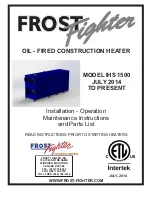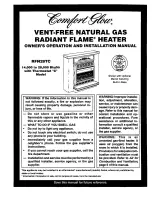
Page
13
of
16
15.
Flue
Gas
Analysers
–
Installation
&
Servicing
Facts
•
Please
read
this
sheet
even
if
you
have
fitted
our
fires
before.
•
Please
leave
this
sheet
with
the
customer
as
reference
for
future
servicing
of
the
appliance.
•
Please
explain
to
the
customer
how
the
fire
works
and
the
details
and
facts
listed
on
this
sheet,
particularly
what
the
catalyst
does
and
doesn’t
do.
•
If
you
have
any
doubts
about
the
test
procedure
please
visit
our
website
or
call
our
technical
help
line
Testing
–
Points
to
note…
•
Before
testing
ensure
that
the
room
size
is
correct
for
the
heat
output
of
the
fire.
30cu³
for
2.5kw
output,
40cu³
for
3.5kw
and
50cu³
for
4.5kw.
•
In
all
installations
regardless
of
room
size
there
must
be
an
air
vent
positioned
at
least
one
metre
from
the
fire
at
either
high
or
low
level
through
an
outside
wall
providing
100cm²
of
free
air.
(For
the
Republic
of
Ireland
2
vents
of
not
less
than
60cm²
must
be
provided
at
high
and
low
level,
with
minimum
vertical
separation
of
1.6m).
•
The
analyser
used
must
be
manufactured
to
BS7967
and
the
test
must
be
carried
out
in
accordance
with
BS5871
Pt
4
•
The
catalytic
converter
needs
heat
to
work,
therefore
before
you
start
testing;
the
fire
must
have
been
lit
and
burning
on
full
for
at
least
15
mins.
There
are
two
tests
to
carry
out.
A
Co
/
CO²
ratio
test
and
a
room
centre
CO
test.
1.
The
first
test
is
the
CO
/
CO²
ratio
test
and
should
be
carried
out
at
the
fire
exhaust
vent,
do
not
stick
the
probe
of
the
analyser
in
through
the
grill
but
move
the
probe
back
and
forth
1
inch
in
front
of
the
outlet
grill.
(We
use
a
piece
of
perforated
8mm
pipe
attached
to
the
analyser
with
flexible
rubber
tube).
You
should
record
a
ratio
of
no
more
than
0.002
%
(20ppm
CO
to
1%
Co²).
It
is
advisable
to
have
a
high
sample
of
CO
as
this
will
improve
the
test
2.
The
second
test
is
the
room
centre
CO
test.
You
should
stand
in
the
room
centre
with
the
probe
at
waist
height
and
read
the
level
of
CO;
this
should
be
no
more
than
9ppm
over
ambient
peak.
Please
record
these
readings
on
the
customers
guarantee
card.
Our
Flueless
fires
also
contain
the
following
safety
devices
(an
ODS
(Oxygen
Depletion
Sensor)
and
FSD
(Flame
Supervision
Device).
Point
out
to
the
customer
that
unfortunately
these
are
not
found
on
all
gas
hobs;
which
are
also
flueless
devices)


































